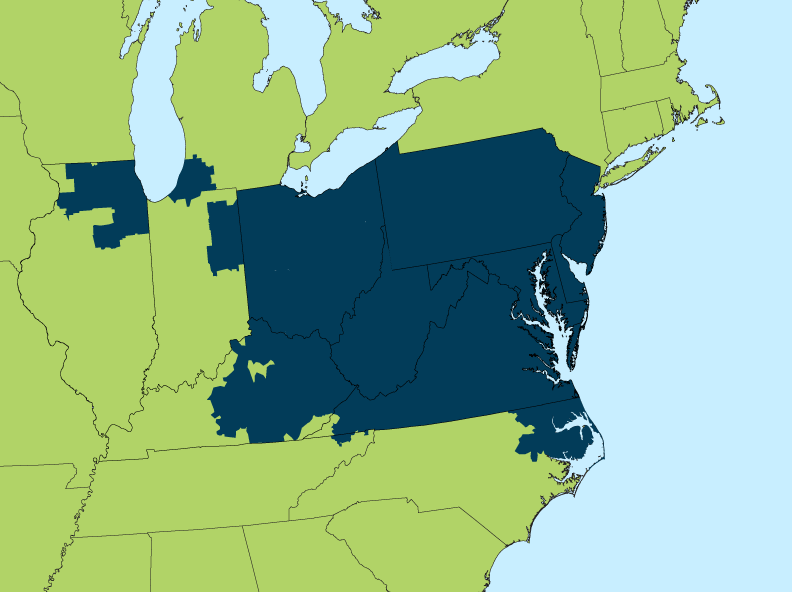
NCEL Blog
Understanding RTOs: the PJM Interconnection
February 17, 2023
Refresher: What is an RTO?
While states set their own clean energy goals and utility policy, wholesale markets and electricity transmission between states are regulated by the Federal Energy Regulatory Commission (FERC). In many cases, this is organized through regional transmission organizations (RTOs). RTOs are responsible for managing the capacity market, which ensures that electricity supply meets future demand with adequate reserves.
What States Make Up the PJM Interconnection?
The PJM Interconnection is the RTO for all or parts of Delaware, the District of Columbia, Illinois, Indiana, Kentucky, Maryland, Michigan, New Jersey, North Carolina, Ohio, Pennsylvania, Tennessee, Virginia, and West Virginia.

Why Should You Care About PJM?
PJM is responsible for both the energy market (the moment-to-moment management of the grid) as well as the capacity market. Capacity markets make long-term plans for how much electricity is needed to meet demand (i.e. capacity) over time. Capacity markets thus influence which new generation gets built or stays online, e.g. a gas plant versus an offshore wind farm. Because PJM controls the capacity market within the region, the decisions they make play a huge role in not only how state policy is implemented, but also in the cost of electricity.
Capacity Market Impacts: Decisions that PJM makes for the capacity market can either help or harm how a state’s Renewable Portfolio Standard (RPS) is implemented. It also impacts the cost of electricity. Two primary issues that legislators have focused on in the PJM region include the Minimum Offer Price Rule (MOPR) and overprocurement.
- Minimum Offer Price Rule (MOPR): In 2021, PJM proposed changes to the MOPR which distorted the capacity market by discriminating against energy resources that receive direct or indirect state support (largely clean energy sources). This determination undermines state Renewable Portfolio Standards or Clean Energy Standards. With the implementation of the MOPR, clean energy resources such as wind and solar would be artificially priced out of participation in the PJM capacity market. Electric costs to consumers were expected to increase significantly.
- Overprocurement: PJM consistently over-purchases electricity generation by as much as double what is needed. In 2021-2022, PJM’s over-procurement cost consumers $4.4 billion in unnecessary capacity, with many of the contracts going towards otherwise uneconomic fossil fuel plants.
What Have States Done Around PJM?
States worked with PJM to revise the Minimum Offer Price Rule (MOPR).
The MOPR would have made it difficult or impossible for renewable energy resources to compete in the capacity market by artificially pricing them out. In March 2021, over 70 legislators from nine states requested that PJM eliminate the MOPR and work closely with state legislators to ensure capacity market rules don’t hinder clean energy resources and prevent states from meeting their renewable portfolio standards.
PJM leadership agreed to meet with state legislators, where they discussed ways PJM and states could better work together to support state clean energy priorities. Following the meeting, 45 legislators from 6 states submitted an official comment letter to FERC requesting the elimination of the MOPR. Later in the year, PJM revised its proposed MOPR to facilitate more participation by state-supported clean energy resources. As a result, over 50 state legislators from eight states commended PJM for these new efforts and encouraged FERC to approve the revised MOPR.
States encourage PJM to stop overprocurement.
In June 2022, legislators from all PJM states called on the Regional Transmission Organization to stop wasting electricity through the practice of overprocurement.
Currently, PJM is consistently over-purchasing electricity generation by as much as double what is needed. In 2021-2022, PJM’s over-procurement cost consumers $4.4 billion in unnecessary capacity, with many of the contracts going towards otherwise uneconomic fossil fuel plants. The majority of these plants are located within five miles of an environmental justice community.
Legislators Will Continue to Work With PJM for a Cleaner and Stronger Grid
Legislators will continue to organize around the region to ensure that PJM is better aligned with state policies around renewable and clean energy.
Learn more about PJM and state action through NCEL’s Success Story: Coordinating State Legislators in PJM States.